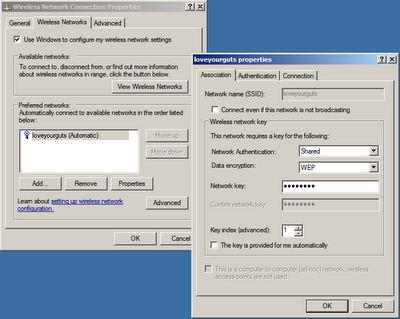Wednesday, August 27, 2008
Delete Temporary ASP.NET Files
- From command line issue a "IISReset /stop" command to stop IIS
- Delete the C:\WINDOWS\Microsoft.NET\Framework\v2.0.50727\Temporary ASP.NET Files\ folder
- Start IIS with "IISReset"
Friday, August 22, 2008
View Message Source in Outlook 2003
The other day I wrote how to view message headers in OWA, and recieved a lot of mail asking if this can be done it Outlook as well. If you have ever used Outlook Express, you might be familiar with the View --> Source option. In Outlook this feature does not exist.
Outlook gives you the option to View --> Options which will display the e-mail header. To enable the View --> Source functionality in Outlook 2003 open up regedit and drill down to:
HKEY_CURRENT_USER\Software\Microsoft\Office\11.0\Outlook\Options\Mail
Create a new Reg_DWORD called SaveAllMIMENotJustHeaders and give it a value of 1. This will enalbe the View --> Source option in Outlook 2003 but there are a few exceptions. It will only work for messages received after the change has been made and will not work with MAPI connections (i.e. Exchange mailboxes). You will only have this option for mail received from Internet transports (i.e. POP3)
Where is the rawurlencode of ASP.NET?
I could not find a function in ASP.NET that behaves like PHP's rawurlencode. System.Web.HttpUtility and HttpServerUtility both have UrlEncode and UrlPathEncode. So I created the function below to extend UrlEncode to manually encode the characters that kept the the filenames from working as an <a href path
/// <summary>
/// HttpUtility.UrlEncode() and Server.UrlEncode()
/// do not urlencode some special characters.
/// This procedure ensures that the file part of the
/// url returned is properly encoded
/// Used http://www.voormedia.com/en/tools/url-encoder-php-asp-urlencode.php
/// to see what characters urlencode to
/// Also http://en.wikipedia.org/wiki/Url_encoding
/// </summary>
/// <param name="Filename"></param>
/// <returns></returns>
public static string GetUrlEncodedFilename(string Filename)
{
string FileNameEncoded = "";
if (Filename != null)
{ FileNameEncoded = HttpUtility.UrlEncode(Filename);
//UrlEncode encodes spaces to pluses. http://forums.asp.net/t/1231078.aspx
FileNameEncoded = FileNameEncoded.Replace("+", "%20");
//Encode ' so the href specification does not terminate
FileNameEncoded = FileNameEncoded.Replace("'", "%27");
} return FileNameEncoded;
}
Here is an online HTML encoder I used to be able to format the code to show up correctly.
Sunday, August 03, 2008
Wireless Mastered!
The solution that finally worked was to disable the LinkSys software managing the network card. Use Windows to manage the connection.
Right click on your network adapter and choose view available network connections. From that screen pick the manage preferred networks. You get the follow dialogs. Manually enter the SSID and other information like your wireless router has them. Bingo, my wireless machine connects automatically, every time.

